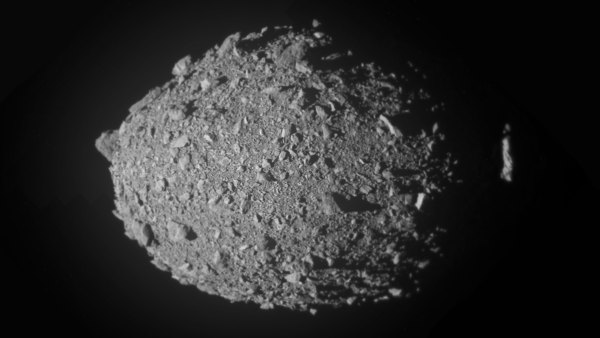The Very Large Telescope identified no water on the asteroid using spectroscopy.
Six months after NASA rammed a spacecraft into an asteroid, experts are starting to understand the mission’s goal.
New ESO findings demonstrate that NASA’s DART mission’s debris from Dimorphos did not include water-ice or thruster fuel.
DART probe finds asteroid Dimorphos to be bone dry.
The MUSE (Multi-Unit Spectroscopic Explorer) instrument on ESO’s Very Large Telescope in Chile shows variations in debris particle size and asteroid light polarization. They might offer specifics about the impact’s ejecta, whose recoil gave Dimorphos the largest thrust.
The Double Asteroid Redirection Test (DART) nudges the 580-foot (177-meter) Dimorphos while it orbits its binary twin, the 2,788-foot-wide (850 meters) Didymos. DART hit Dimorphos on Sept. 26, 2022, changing its orbital period by 33 minutes to demonstrate that Earth-threatening asteroids may be deflected.
“Before the impact, we weren’t really sure what to expect,” University of Edinburgh’s Cyrielle Opitom told Space.com.
Asteroids are generally stony and kept together by gravity, although some include water ice. NASA’s Infrared Telescope Facility in Hawaii saw water ice on the asteroid 24 Themis in 2009. How it got there is unknown. Certain asteroids may have ice under their surfaces, which may have originated distant from the sun before moving inward. Asteroids may have brought Earth’s water.
Opitom led a MUSE team searching Dimorphos for water. From before the impact until a month following, they saw the Didymos–Dimorphos system 11 times. MUSE splits the light from the double-asteroid into a rainbow of colors to search for molecules at certain wavelengths. Opitom’s team looked for water molecules and oxygen from impact-broken water molecules in the ejecta. Water was absent. Dimorphos appears dry.
DART’s hydrazine fuel and xenon from its ion engine were not detected in the ejecta, although their modest amounts are expected.
MUSE’s observations tracked the evolution of the cloud of ejecta (debris) blown up by the impact and helped identify the size distribution of dust particles in the cloud and afterwards in the tail streaming away from the asteroid.
DART’s collision with Dimorphos blasted 900,000 kg of dust into space. After a few hours, sunlight and Didymos’ gravity twisted the cone-shaped ejecta cloud. After weeks, a dust tail formed.

VLT observations match March Hubble Space Telescope data.
Opitom claimed that Hubble scans showed that the tail’s particles were 1-10 microns when it emerged. “We didn’t spot the tail because our observations had lesser spectral resolution and sensitivity than Hubble’s. Later, when somewhat bigger particles prevailed, we found it.”
Opitom stated this matches the VLT and MUSE’s hue of the ejecta, which is bluer for smaller dust particles and redder for bigger ones.
Opitom reported the tail was redder than the ejecta, which was somewhat bluer. Hence, the early ejecta cloud had smaller dust particles than the slower dust in the long tail.
DART pushed an asteroid and let scientists see it collide with another object. Active asteroids, which have tails, may have been formed by collisions.

